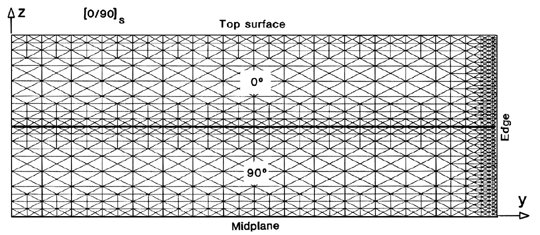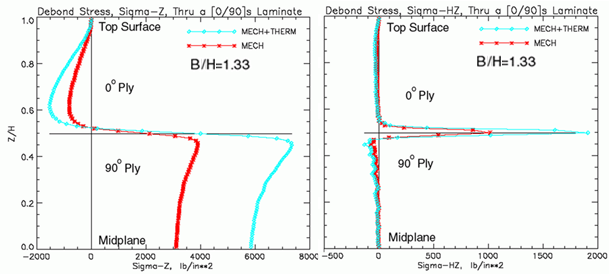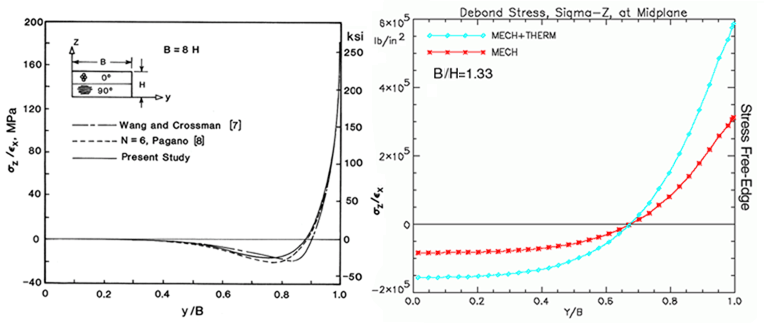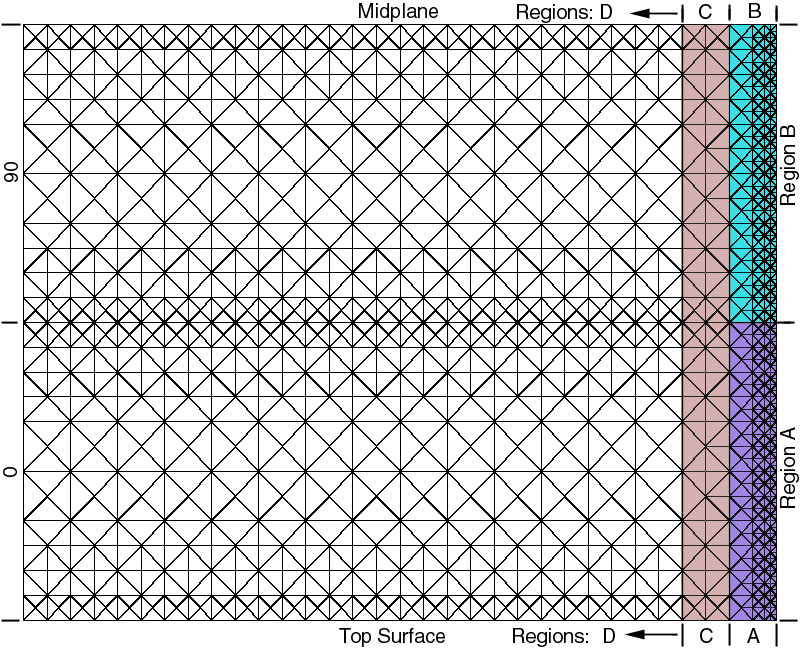Generalized Plane Strain FEM Problem: NPIB
Submit batch job to compute stresses in a [0/90]s "bi-directional"
Glass/Epoxy Laminate "Stress Free-Edge" Problem"
(Comparison with Pipes & Pagano solution)
Instructions for using this form:
- Enter appropriate numbers in the boxes,
- enter your email address,
- click on submit, and
- wait for results to be returned to your email.
(this will take about 20 seconds)
- Web location of results: we090.html will be sent to your email address.
- If your email does not provide direct email links, copy and paste the
web address: http://www.jwave.vt.edu/output/we090_"unique
date-time"/we090.html from the email into your web browser
Location: window and look at this file to see if the job ran correctly.
- If the job ran correctly you can now download files from your
web browser to your computer for archiving (a 4.6Gbyte read/write optical
disk is available for each student to use in the SMVC for archiving large
simulation files).
- If you submit the form "as-is", a sample of results has been archived in the directory:
http://www.jwave.rkriz.net/output/ARCHIVE_Examples_SAVE/wedge090_10-23-2000-8:35:41:442/
Select
we090.html
to see a summary of the results.
Below is a description of the laminate geometry and finite element grid representation
used to define the "Stress Free-Edge" problem. A detailed explanation of the
"Stress Free-Edge" problem is given in Ref.[23],"Interlaminar Stresses in Composite Laminates
Under Uniform Axial Extension", J. Composite Materials, Vol. 4, pp.538-548, (1970).
As a summary the figures below shows the laminate stacking sequence, FEM grid, and stress
distributions for this specific problem. Example of results shown below demonstrate how
"Free-Edge" stresses are signficantly influenced by anisotropy and thermal loads.
Notice how the sigma-z and sigma-hz stresses are influenced by thermal ("THERM")
conditions supperposed with the mechanical ("MECH") load case.
These three stress distributions are significantly influenced by the combination of residual
stresses caused by the thermal contraction at low temperatures, Delta-T=-100F,
such that the debonding will most likely occur at the 0/90 interface and not the laminate
midplane. NOTE: the sigma-z midplane stress distribution along the y/B axis can be compared
with the classic Pipes & Pagano finite-difference numerical solution in Ref.[16], see Figure 3.
In this problem it is not necessary to calculate the out-of-plane strain from Linear Elastic
Laminated Plate Analysis (LELPA), since the objective here is to focus just on the stresses
near the "Free-Edge" and normalize the sigma-z stress vs. y/b with respect to the out-of-plane
strain, see Figure 3. Therefore an out-of-plane strain of 0.0100 was chosen instead of
calculating this strain by LELPA. However the LELPA solution (
module05b) to this problem can be compared to the stresses predicted far from the
"Free-Edge".

Figure 1. Schematic and FEM grid of a [0/90]s laminate

Figure 2. Stresses in the 0 and 90 degree plies

Figure 3. Comparison with other numerical "Stress Free-Edge" solutions, Ref.[16]
Numbers provided in the NPIB (Network Programming Interface Builder) form below match
this particular problem. Of course with the NPIB form a variety of other configurations
are possible.
NOTE: We have provided a complete set of ELEMENT NUMBER GRIDS below so that
the student can calculate stress distributions different from the three graphs
shown above.
 Region-A /
Region-B /
Region-C /
Region-D
You might want to reproduce the results shown in th figures above using the form in the
frame provided below. You can compare these results with the Linear Elastic
Laminated Plate Analysis (LELPA) program in "module05b" which
assumes the stresses associated with the z-axis can be neglected.
Region-A /
Region-B /
Region-C /
Region-D
You might want to reproduce the results shown in th figures above using the form in the
frame provided below. You can compare these results with the Linear Elastic
Laminated Plate Analysis (LELPA) program in "module05b" which
assumes the stresses associated with the z-axis can be neglected.




